How do I interpret €urostars on catalogues?
When looking at a catalogue, it can be daunting to interpret what the contents displayed mean. €uroStars attached to an animal remain to be WITHIN BREED, ranking each index in 20% groupings. The higher the stars, the higher the predicted profitability from that animal within that breed. Since 2019 the €uro values of each trait and index can be compared ACROSS BREEDS, which allows any two rams to be compared to each other regardless of breed.
Lets walk through two different scenarios to see how this information would affect a farmers decision. If we assume in this case that the farmer intends to produce 100 lambs per year from this ram, and that he will be used for 4 breeding seasons. That means the ram will produce approximately 400 lambs in his lifetime.
Scenario 1: The farmer has decided they want a ram to breed replacement females, and he is happy to use a Charollais or Texel to do this. Below are the two potential rams they have identified. Ram A has a Replacement Index of €2.75 (1), and Ram B has a Replacement Index of €-0.70 (2).
RAM A: €2.75 x 400 lambs = €1,100
RAM B: -€0.70 x 400 lambs = -€280
Predicted Difference in Profit between Ram A & B= €1,380
The consequence of this decision is the predicted difference in adding €1,100 to the bottom line or losing €280 based on the genetic potential of each ram. In this scenario, RAM A is the better ram.
Scenario 2: The farmer has decided he wants a ram to breed only factory lambs, and he is happy to use a Charollais or Texel to do this. Below is are the two potential rams he has identified. Ram A has a Terminal Index of €0.46(1) and Ram B has a Terminal Index of €1.41 (2).
RAM A: €0.46 x 400 lambs = €184
RAM B: €1.41x 400 lambs = €564
Predicted Difference in Profit between Ram A & B= €380
The consequence of this decision is the predicted difference in adding €564 to the bottom line or €184 based on the genetic potential of each ram. In this scenario, RAM B is the better ram.
These scenarios are based on selecting one ram, if a farmer uses a team of rams, they could be losing a lot of performance and profitably by not using the €urostars as a tool when selecting their breeding rams.
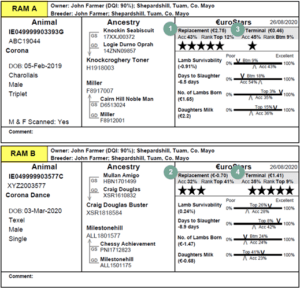
Below in Figure 4, each of the €urostars are broken down into percentiles which facilitates farmers in identifying the top % of the best genetics within a particular breed, ie a 5 star Texel ram – is in the top 20% within the Texel breed.
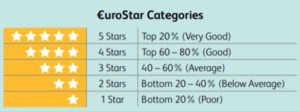
1) Replacement (€3.44) – If a farmer desires a ram to breed both lambs both for slaughter and replacement ewe lambs then they should select a ram based on this index. The bulk of this index is a combination of Lamb Survivability, Days to Slaughter, No. of lambs born & Daughters milk. The ¼ value beside the index represents the difference in profit that each lamb sired from this ram will have. This € value is an across breed value, so different breeds can be compared to each other.
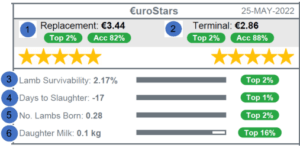
2) Terminal (€2.86) – If a farmer desires a ram to breed only lambs for slaughter then they should select a ram based on this index. The bulk of this index is a combination of Lamb Survivability and Days to Slaughter. The ¼ value beside the index represents the difference in profit that each lamb sired from this ram will have. This € an across breed value, so different breeds can be compared to each other.
3) Lamb Survivability – This ranks animals based on lambing ease and lamb survival rate. Every positive % point on this index is an extra lamb surviving to 40 days and vice versa.
4) Days to Slaughter – This ranks animals on their genetic ability to grow. The index associated with this trait represents the difference in the predicted number of days required for the progeny of this ram to reach the desired slaughtered weight compared with other animals of the same breed.
5) No. of Lambs Born – This ranks animals based on the predicted prolificacy of the females from this animal compared with other animals of the same breed.
6) Daughters Milk – This ranks animals based on the predicted milking performance of their daughters compared with other animals of the same breed.
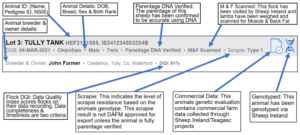
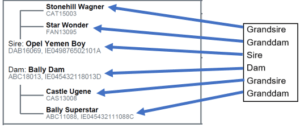
How can a ram have a poor rating for number of lambs born, and still be 5 star on the replacement index?
The replacement index is made up of a combination of lamb survivability, ewe mature weight, lambing difficulty, number of lambs born and lamb growth traits, each of which are weighted according to their effect on flock profitability. Where an animal is weak on one trait but strong in all other traits that make up the overall Replacement Index this can make up for the trait the ram is weaker on.
Should physical checks be carried out on rams?
Regardless of what €uroStar Index a ram may have, if the ram is not physically correct, he should not be selected. All farmers should carry out a ram NCT (check) on all existing stock rams and rams being considered for purchase. There are five basic things all sheep farmers should consider at – these can be summarised as the 5 T’s;
- Timing – assessed 10-12 weeks prior to breeding season
- Tone – ensure good condition, fit for purpose and not over fat
- Teeth – check for bumps/abscesses etc
- Toes – as well as legs – check for lameness, injury etc
- Testicles – check for lumps, small or undescended, the penis should also be checked for any injury or infection

